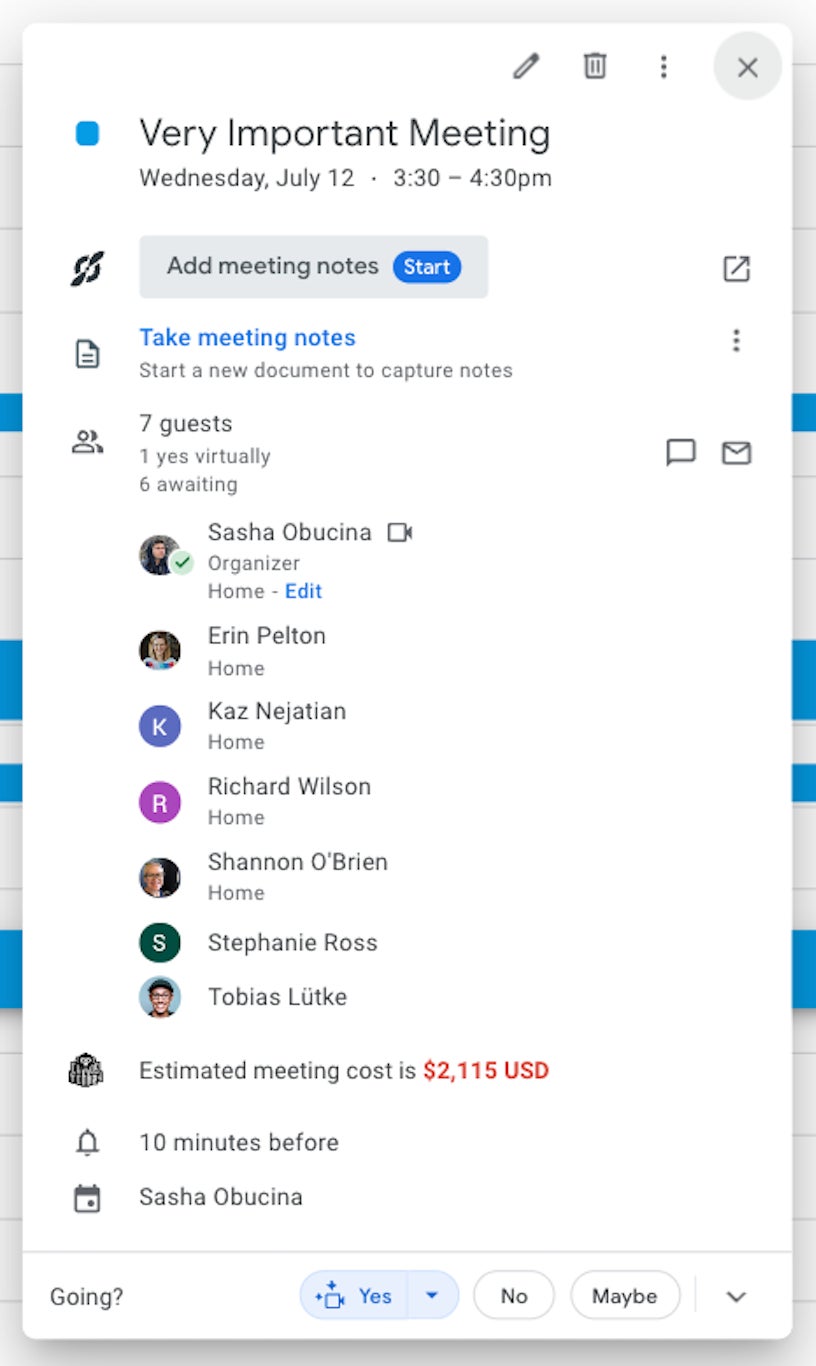If you want fewer meetings, measure them in cash
What's your meeting really costing you? Shopify has some thoughts.

Venture to a certain corner of the Internet, and you’ll find an uncanny kind of social satire: that of the wishful work design. There’s the made-up meeting punctuality score, which tells you who among your invitees is most likely to show up to the brainstorm 10 minutes late. Or the fictitious LinkedIn nepotism disclosure, which adds a label to tell you which manager is actually just related to the boss. In this alternative digital world, software plays the banality of emails like music. A version of Zoom lets you skip through throat-clearing intros like a Netflix title series. And a feature of Google Calendar shows the cost of a useless meeting before you call it.
They’re just imagined concepts, a way to lampoon our workplace norms. Well, except the last one. Now one company has built that tool for real.
Shopify is making employees calculate the cost of meetings before they go on the calendar
Today (July 12), e-commerce company Shopify announced a new tactic directed at dropping useless meetings: a cost calculator, which estimates the price of any meeting with three or more people. Now when employees open their Google Calendar to schedule an event, an integrated tool will use average pay data, the number of attendees, and the event length to spit out a projected price. That hourlong sync? It’ll cost $2,115 USD.
The tool, first created in a company-wide hackathon, is available just to Shopify employees for now. The goal: discourage unnecessary meetings by showing everyone what they cost.

“For us, the dollar value is not the point,” says Shopify chief operating officer Kaz Nejatian in an email to Quartz. “The cost calculator is here to challenge the status quo, nudging our teams to reconsider meeting necessity and explore more creative collaboration methods.” By integrating the tool into the team’s current workflow, he adds, the idea is to surface costs in a way that’s immediately noticeable to employees without having to change their day-to-day.
We’re spending much too much time in meetings
Thanks to the pandemic-era change to remote and hybrid work, we’ve all become mired in meetings. One Microsoft report finds that the average Teams user saw a 252% jump in the time they spend in meetings weekly from 2020 to 2022. The number of meetings increased, too, shooting up more than 150% for workers across the globe. All that time in the boardroom, whether virtual or IRL, doesn’t leave much time to actually get things done.
For its part, Shopify has been making a larger push to pare back its own pointless meetings. In January, the company piloted a company-wide meeting reset, where it canceled more than 12,000 recurring events on employee calendars in a bid to cut back on meetings that weren’t worth anyone’s time. Leaders say it now spends an average of 14% fewer minutes in meetings, and it’s on track to ship about 18% more projects this year.
The rise of the meeting cost calculator
The idea of calculating meeting costs isn’t an entirely new one. In 2016, the Harvard Business Review released an app aimed at putting a price tag on a meeting. Plenty of online tools let you track the cost of time you put on the calendar. And it’s not Shopify’s first foray into measuring the fee for that brainstorm, either. “In our first office in Ottawa, we had a physical meeting cost calculator and clock,” says Nejatian. “This is the digital version of that.”
A modest meeting proposal from Quartz
So why stop at cost calculators and talk tabulations? Bad meetings are ripe for reinvention. Maybe you’d appreciate a jargon transcriber that translates all the meaningless buzzwords people drop in real time, or a sound minimizer that mutes those desk neighbors forever talking about last night’s football game. Or maybe you’d benefit from an extension that visualizes how much someone’s speaking is dominating the Google Meet, a very real tool recently released in the Chrome store.
Like any other workplace, Quartz has its own complaints, too. Our newsroom compiled some suggestions for the digital tools that target some of meetings’ worst offenders.
When the meetings always run over
🦈 For virtual meetings prone to going overtime, the speaker gets a background that looks like a shark is chasing them. They need to complete their thought within 30 seconds, or they get Jaws’ed. —Julia Malleck, staff writer
🔥 Everyone on Zoom gets a digital torch and an allotted speaking time. When you’ve used yours up, Jeff Probst joins the meeting to extinguish your flame. The tribe has spoken. —Gabriela Riccardi, deputy editor
🎻 At the scheduled end time, swelling orchestral music plays over the speakers, eventually so loud that it’s the only thing anyone can hear. —Susan Howson, executive editor
When the meetings give everyone agita
😸 For those with a fear of virtual public speaking, a plugin turns everyone’s faces on their screen into cute animal emojis to calm their nerves. No need to disclose who’s a cat. —Michelle Cheng, reporter
🎥 And for those who are better at meeting from home, choose a new kind of virtual background that’s just a live feed from the office floor—and get a little less pressure from your manager on that in-person policy. —Gabriela Riccardi
When the meetings could use a referee
🚨 When someone starts in with self-important pontification, the mansplain-machine will begin flashing their box red, inflating their video to the size of an uncheckable ego. Meanwhile, a microaggression monitor will throw yellow flags all over the screen the next time someone calls your colleague “articulate.” —Gabriela Riccardi
When the meetings shouldn’t exist at all
🌀 A plugin that randomly shuffles everyone’s name onscreen. There’s no point to this, just like the meeting. It’s just for the chaos. —Julia Malleck
This story has been updated.